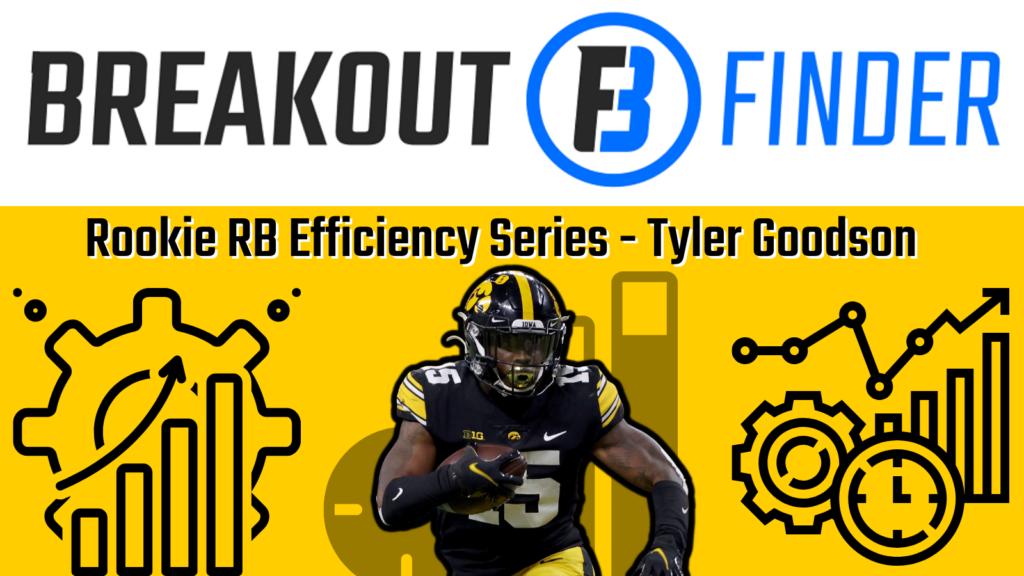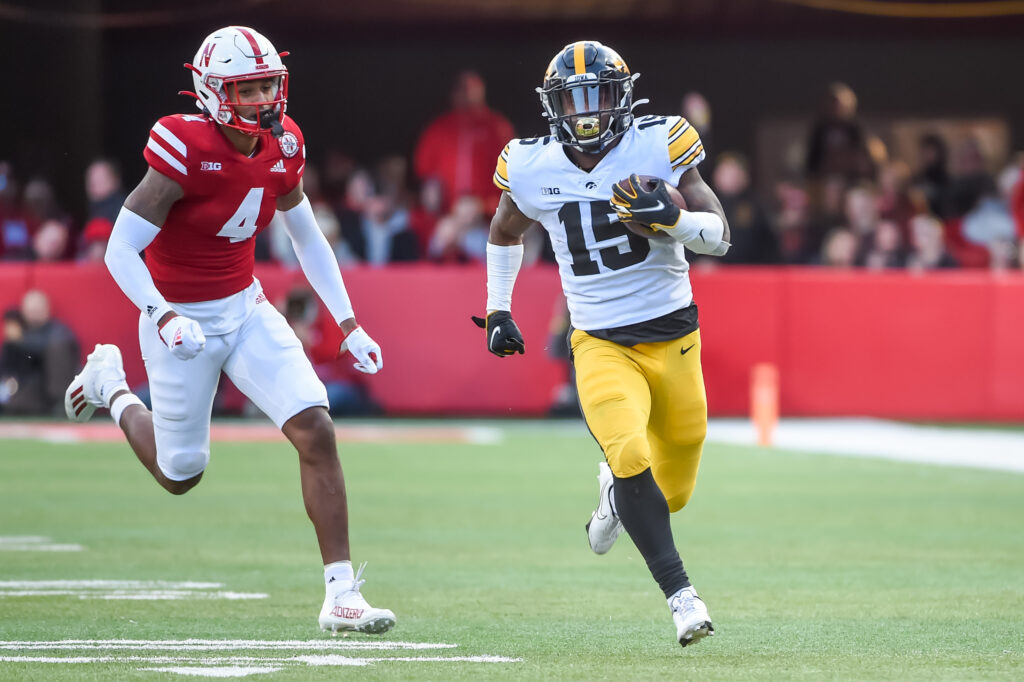This article is part of a series in which I evaluate 2022 rookie running backs solely on their ability to run the ball. The first installments can be found here. I’ve changed up my methodology a bit since publishing those articles, which I go over in detail in this process-focused piece. I’ll give a quick refresher below, but also feel free to skip straight to the player-focused analysis below the picture of Iowa’s Tyler Goodson a couple paragraphs down.

Outside the ability of whoever happens to be running the ball, there is a whole mess of variables that factor into the effectiveness of a given rushing attack: scheme, play-calling tendencies, opponent strength and scheme, weather, offensive line play, surrounding skill-position talent, etc. And given this entanglement, separating the contributions of the ball carrier from the offensive environment in which he operates is not a straightforward task. My approach to doing that is centered around measuring the degree to which a running back is over- or under-performing the per-carry output of the other running backs on his team.
Starting from the premise that good runners do more with what they are given than do bad runners, it stands to reason that, provided players are operating under generally the same conditions (like, for example, playing on the same team), better backs should produce more per carry than lesser backs. Using this logic, we can establish a baseline for comparing efficiency between players on the same team; for each running back, we can compare his performance (X) to the collective performance of every other running back on the team (Y). If X > Y (essentially, if dude is doing more with his carries than his teammates are with theirs), we can probably conclude that the player in question is a good player, at least to some relative degree.
Assuming that this is a sound method of evaluating running backs relative to their teammates, we can then extend our comparisons to players from other teams (we’re really just creating a baseline for efficiency comparisons similar to how Dominator Rating and other market share-based metrics create baselines for volume-based comparisons).
The key metrics I use to evaluate running back performance vs. that of their teammates are called Yards Per Carry+, Chunk Rate+, and a metric I developed recently called Box-Adjusted Efficiency Rating, or BAE. I also like to use a metric called Breakaway Conversion Rate, but that is not a teammate-relative measure and we’ll therefore look into it separately.
The metrics are pretty straightforward: YPC+ is the degree to which a player over- or under-performs his teammates in yards per carry, and Chunk Rate+ is the degree to which a player over- or under-performs his teammates in rate of “chunk” runs (which I classify as runs of 10 yards or more). At a basic level, I want my running back prospects to find a way to produce more per carry than the other backs on the team, and part of that puzzle is navigating the line of scrimmage and extending runs into the secondary at a higher rate than his backfield mates. YPC+ and Chunk Rate+ measure the degree to which a player does both of these things.
BAE also does those things, but it improves upon Yards Per Carry+ by using a weighted average of a player’s per carry efficiency on carries vs. various amounts of defenders in the box (using data from Sports Info Solutions), relative to the per carry efficiency of other running backs on his team vs. the same box counts. The resulting percentage indicates to what degree a runner over- or under-performed his teammates on his total rushing attempts, relative to how often he faced each box count. BAE is a more comprehensive metric than is YPC+, and I will defer to it accordingly, but YPC+ and Chunk Rate+ will still be used given that the sample of data I have for those metrics goes back a decade-plus (while I’m only able to generate BAE Ratings going back to the 2018 college football season).
THE METRICS

Former Iowa Hawkeye Tyler Goodson is a guy I’ve been on for a couple years now. And after having a lot of enthusiasm over an impressive start to his career, I’m a little disappointed in the plateauing I see in his rushing efficiency profile over the last two years. In his true freshman season, I was really excited to see him produce well, contribute at a high-level in the passing game, and show upside as a raw but talented runner. The problem is that’s what I still see. He leaves his college career as a productive player with high-end receiving chops and rushing efficiency numbers that suggest some meat left on the bone.
Over his three years at Iowa, Goodson outdid a mediocre group of running back teammates (they were rated an average of 2.88 stars as high school recruits, a 32nd-percentile number among teammates of backs drafted since 2007) by just 0.03 yards per carry, doing essentially on a given carry what any other Hawkeye back was doing on theirs. That 30th-percentile per carry output was accomplished on box counts that were actually 0.05 defenders heavier on average than what his teammates were facing (48th-percentile).
Interestingly, this makes Goodson the only sub-210 pound running back in this class to face heavier boxes than other backs on his team, as well as the only one to do so while also being a top-end threat in the passing game (as judged by my running back model’s composite Receiving Chops Score, among 2022 backs with scores above the 60.0 out of 100 mark). Listed at 5-10 and 199-pounds and having averaged more than two receptions per game for his college career, he looks like a traditional satellite back. And yet defenses were packing the box to stop him at a rate higher than almost any other back I’ve pulled box count numbers for yet, with A.J. Dillon‘s 7.40 average defenders in the box the only mark higher than Goodson’s 7.01 career mark that I’ve seen.
Regardless of whether those high box counts are attributable to respect given to Goodson or respect not given to Iowa’s passing game, it’s what he had in front of him. And relative to those box counts, his average carry was worth 98.8-percent of the average carry from his backfield mates. That 11th-percentile BAE Rating is just plain bad, especially when the relative lack of talent possessed by his teammates is kept in mind.
Goodson does look better from a slightly different perspective, as even against those higher box counts, he ripped off chunk gains of at least 10 yards at a 2.69-percent greater clip than other Iowa backs (67th-percentile), and then converted those chunks into breakaway runs of at least 20 yards at a 59th-percentile rate of 32.5-percent. Film study is an important complement to the metrics-based analysis I’m doing here, but the numbers paint a picture of a guy who was dynamic in space but overmatched at the line of scrimmage.
RUSHING EFFICIENCY SCORE AND COMPS
In my running back model’s (I hate calling it a model because it sounds pretentious and it’s not really a “model” but wtf else am I gonna call it) composite Rushing Efficiency Score (which accounts for all the non-BAE metrics I’ve touched on here as well as overall team quality, offensive line performance, rushing volume, and strength of opponent), Tyler Goodson earns a 58.2 out of 100, which is very solid. BAE Rating is not as kind to him, and in a prototype composite score accounting for the box count data, he scores a 40.6 out of 100. That’s obviously not a great number, but it does put him at or above the same level of other undersized backs in this class like Sincere McCormick and Kyren Williams.
The running back model also generates comps, and in the “pure runner” category (which accounts for the same metrics as the Rushing Efficiency Score, in addition to physical attributes like height, weight, and athletic testing numbers), the following are Goodson’s most similar players (assuming he’s 5’10-199-pounds, and runs a 4.50 forty):

We’ve got a bunch of undersized guys up there who were good in the open field while contributing just about what their teammates did on the per carry aggregate (2022 classmates Tyler Badie and Kyren Williams are actually among Goodson’s most similar pure runners as well, but I leave fellow rookies off the list as it doesn’t offer much insight to comp them to each other), and the hit rate among these backs obviously isn’t great. The differentiator with Christian McCaffrey is that he had marginally better efficiency than a very talented running back room, while most of the rest of the list were split decision-ing with teammates of average talent.
LAST WORD
Given my early enthusiasm for Tyler Goodson and his failure to really build upon a strong freshman season with greater maturity as a rusher, I started this article with my intellectual honesty hat on, ready to pump the brakes and tear down the rookie draft sleeper banners. But damn it, I’m back in. If you like Kyren Williams, I simply don’t see how you can not like Goodson. The most likely outcome for any player is that they simply don’t make a difference as a pro, but there’s reason to believe that both Williams and Goodson could be undersized all-purpose backs somewhere on the Dion Lewis–Austin Ekeler spectrum. It’ll probably cost you a late first round rookie pick to hop on the Williams bandwagon, but it certainly won’t be that expensive to get a seat on the Goodson express.
